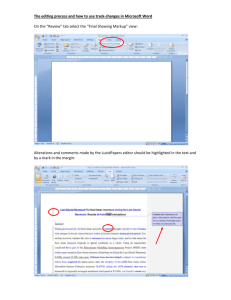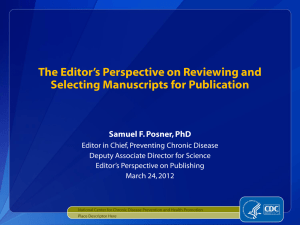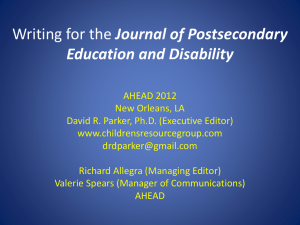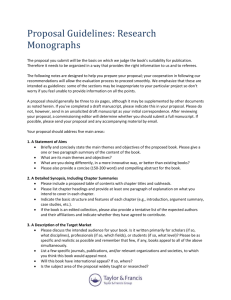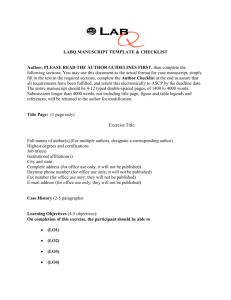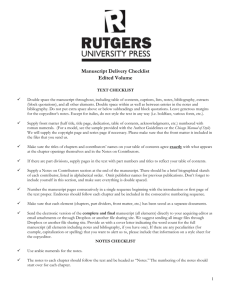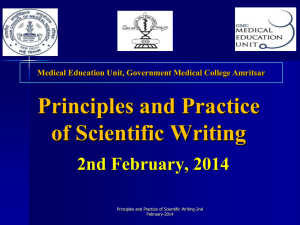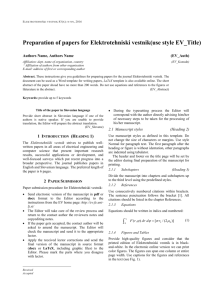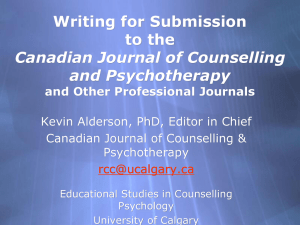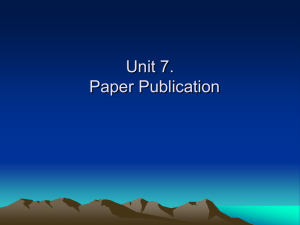PowerPoint Presentation - Scientific papers their
advertisement
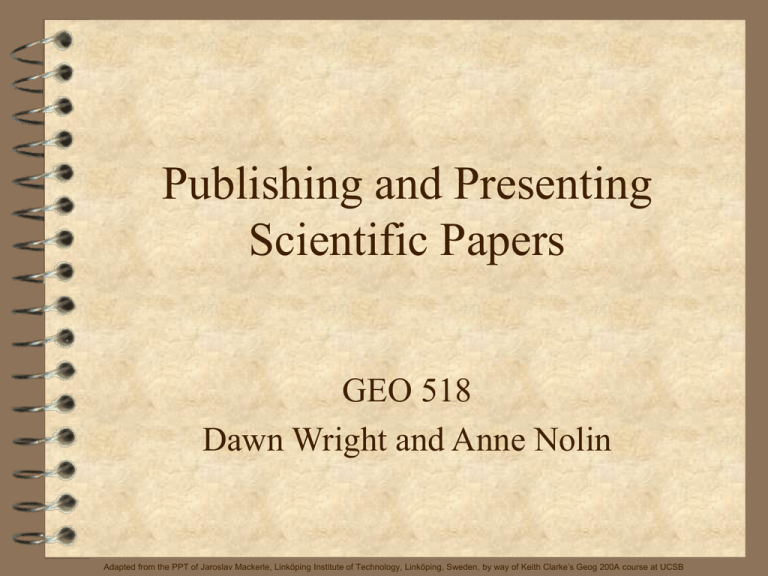
Publishing and Presenting Scientific Papers GEO 518 Dawn Wright and Anne Nolin Adapted from the PPT of Jaroslav Mackerle, Linköping Institute of Technology, Linköping, Sweden, by way of Keith Clarke’s Geog 200A course at UCSB Introduction A naturalist’s life would be happy one if he had only to observe and never to write (Charles Darwin) In science, no matter how spectacular the results are, the work is not completed until the results are published. Let’s explore the main steps from rough manuscript to published paper. Contents kinds of scientific written From an idea by way of rules to the published paper communication scientific writing in general IMRaD format paper organization paper writing paper submission the editing process proof-reading … and pointers to reading Scientific written communication Reports Theses or dissertations Journal articles Books and book chapters Technical manuals/users guides Research or grant proposals Slide presentations Posters Scientific writing in general Subject Purpose – to exchange the scientific knowledge – to ask and answer specific questions Audience – scientists and those interested in the subject – a publisher or an editor ”IMRaD” format Introduction Methods Results and Discussion What problem was studied? What others and you did? Your study area. How do you did it? What did you find out? What do your findings mean?... Combine w/conclusion/summary and future plans Other types of journal papers Review Technical note Letter to the editor State-of-the-Art Example of other types of articles, including technical notes or data briefs: http://www.agu.org/journals/gc/ Steps in scientific journal writing Cowriters Referees Writer Journal editor Readers Paper organization Introduction – call attention to the specific subject, define the problem – provide background and present the results of other studies (literature review) – list the structure of your research project and what you plan to present in your paper Reading a scientific article isn’t the same as reading a detective story. We want to know from the start that the butler did it (Ratnoff, 1981) Paper organization Methods – complete information of materials and methods used, conditions present, actions, experimental design, etc. – this section usually has subheadings; when possible match those to be used in Results – enough information must be given so that the models/experiments can be reproduced – ask a colleague if he/she can follow the methodology Paper organization Results – display of data with logical development showing how your findings satisfy your objectives – where possible give illustrative examples and compare those with known results from literature – use tables and figures – the fool collects facts; the wise man selects them (J. W. Powell, 1888) Paper organization Discussion – the hardest section to write – discuss, without just repeating the Results – show the relationship among observed facts Conclusion or Summary – state your conclusion(s) as clearly as possible – summarize evidence for each conclusion • end with a short statement regarding the significance of your work Literature Review Revisited Exploring ideas on your subject – gaps in research on a subject of interest – existence of any duplication to your work Conducting a specific search – manually in the library – on-line searching Keep up-to-date with the specific subject A rough draft perhaps but …. Will you have co-authors? Which journal to submit your manuscript? How soon will it be published? How to deal with editors? Journals - Publishers Professional societies – – – – – AAG AGU URISA ESA AFS Professional publishers – Elsevier – Pergamon Press – Springer Verlag – J Wiley & Sons – Kluwer Academic Publishing – Blackwell Taylor & Francis – Academic Press Where to submit the manuscript The prestige factor The circulation factor The frequency factor The audience factor What is the publisher’s practice w/libraries? – Will they have access to the journal for reasonable price??? Journal Citation Reports jcrweb.com Paper writing Write a rough outline first, fill it in A rough draft is ready Select the journal and read Instructions to Authors (manuscript requirements: style in headings, the system for citations, figures and tables, etc.) Write the final manuscript Write or refine your abstract Carefully choose keywords (increases success with e-databases and search engines) The final draft Front Matter – Title (fewest possible words that describe the contents) – Author’s (co-authors) name and address – Abstract (miniversion of the paper, no citations) – Keywords Article Body (IMRaD) – Introduction – Methods – Results – Discussion/Conclusion End Matter – Acknowledgment (technical help and financial assistance) – References (EndNote has style guides) – Appendices Abstracts Descriptive abstract – or topical abstract, describes the contents but contains too little substance and detail Informative abstract – self-explanatory report on a scientific investigation (research objectives for conducting the investigation, the basic method used, and the results and significant conclusions) - 200 to 250 words Extended abstract (conference proceedings) Don’t ignore those keywords! Citations and references For a better credibility you have to review the literature and show that your contribution extends from a solid foundation of research Quality and quantity of the sources you have consulted will enhance your work You have make it possible for readers to retrace your steps Your references can be as valuable as your research methods and findings Check Information for Authors section Citations: Name-year system Examples in the text: – Salwasser (1992) developed a … – …realism or humanism (Schmitt, 1986). – Many other have surveyed (Schmitt, 1986; Teal, 1981) References – Salwasser, K. Landscape Metrics, …… 1999. – Schmitt, L. A. Symposium and concluding remarks,…1986. – Teal, D.W. … 1981 Note: list of references in author alphabetical order Ethics of scientific writing Avoid dual publication Don’t use the work of others without appropriate attribution List only those co-authors who contributed substantially to the work Final submission In-house reviews required? Submit the paper to the journal’s editor (only to one journal) – Hard-copy of manuscript (usually three or more copies) – Disk of the same version • Text: Word, Word Perfect, TeX/LaTeX, etc. • Figures: tif, gif, postscript, etc. – E-Journal submission Editing process Editor logs a manuscript and sends an acknowledgement that the paper has been received Editor sends the manuscript to reviewers On the basis of the reviews and the editor’s opinion, your paper will be accepted, conditionally accepted, or rejected. Checklist for referees Proof-reading Proof-reading and return to the editor Copyright transfer Offprint order Davis, M. Scientific Papers and Presentations, p.88 Copyright Statement from Journal Be sure to read thoroughly For theses read UMI Microfilm statement Make sure you agree with points Will you be free to send or post to web the final pdf?? Congratulations Bibliography Davis, M. Scientific Papers and Presentations, Academic Press, 1997 Day, R. A. How to Write and Publish a Scientific Paper, 4th Ed., Cambridge University Press, 1995 Michaelson, H. B. How to Write and Publish Engineering Papers and Reports, 3rd Ed., Oryx Press, 1990 O’Connor, M. Writing Successfully in Science, Academic Press, 1991 Paradis, J. G. and Zimmerman, M. L. The MIT Guide to Science and Engineering Communication, MIT Press, 1997 … and more books Briscoe, M.H. A Researcher’s Guide to Scientific and Medical Illustrations, Springer-Verlag, NY, 1990 Hodges, E. R. S. The Guild Handbook of Scientific Illustration, Van Nostrand-Reinhold, NY, 1989 Reynolds, L. and Simmonds, D. Presentation of Data in Science, Nijhoff, Hague, 1983 Smith, R. V. Graduate Research: A Guide for Students in the Science,ISI Press, Philadelphia, 1984 Stock, M. A Practical Guide to Graduate Research, McGraw-Hill, NY, 1985
